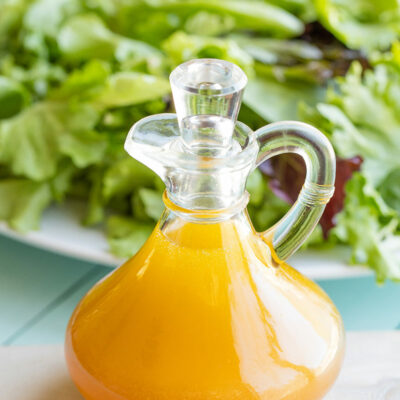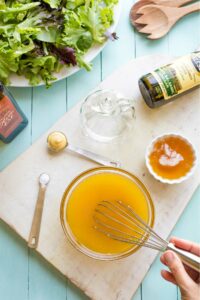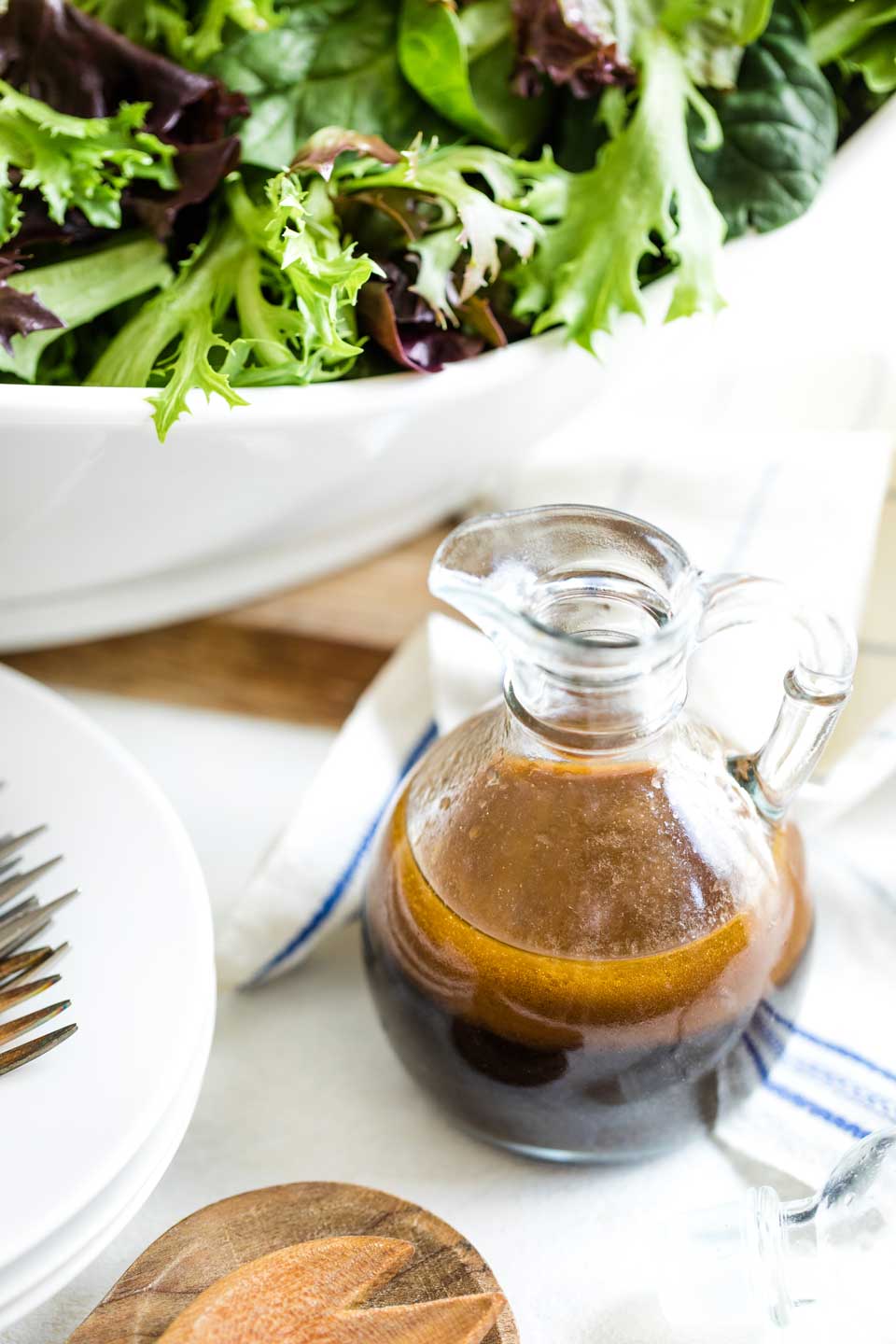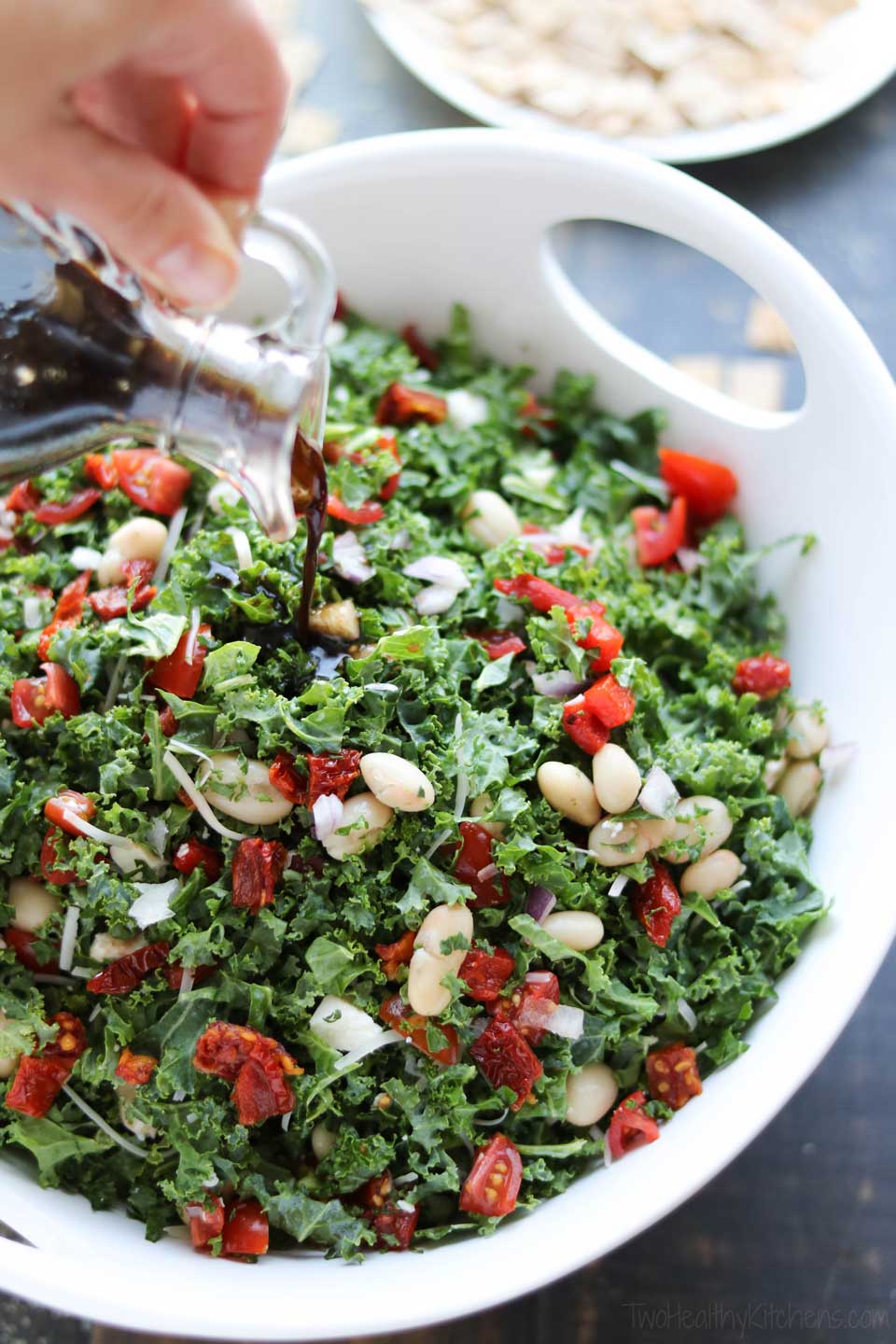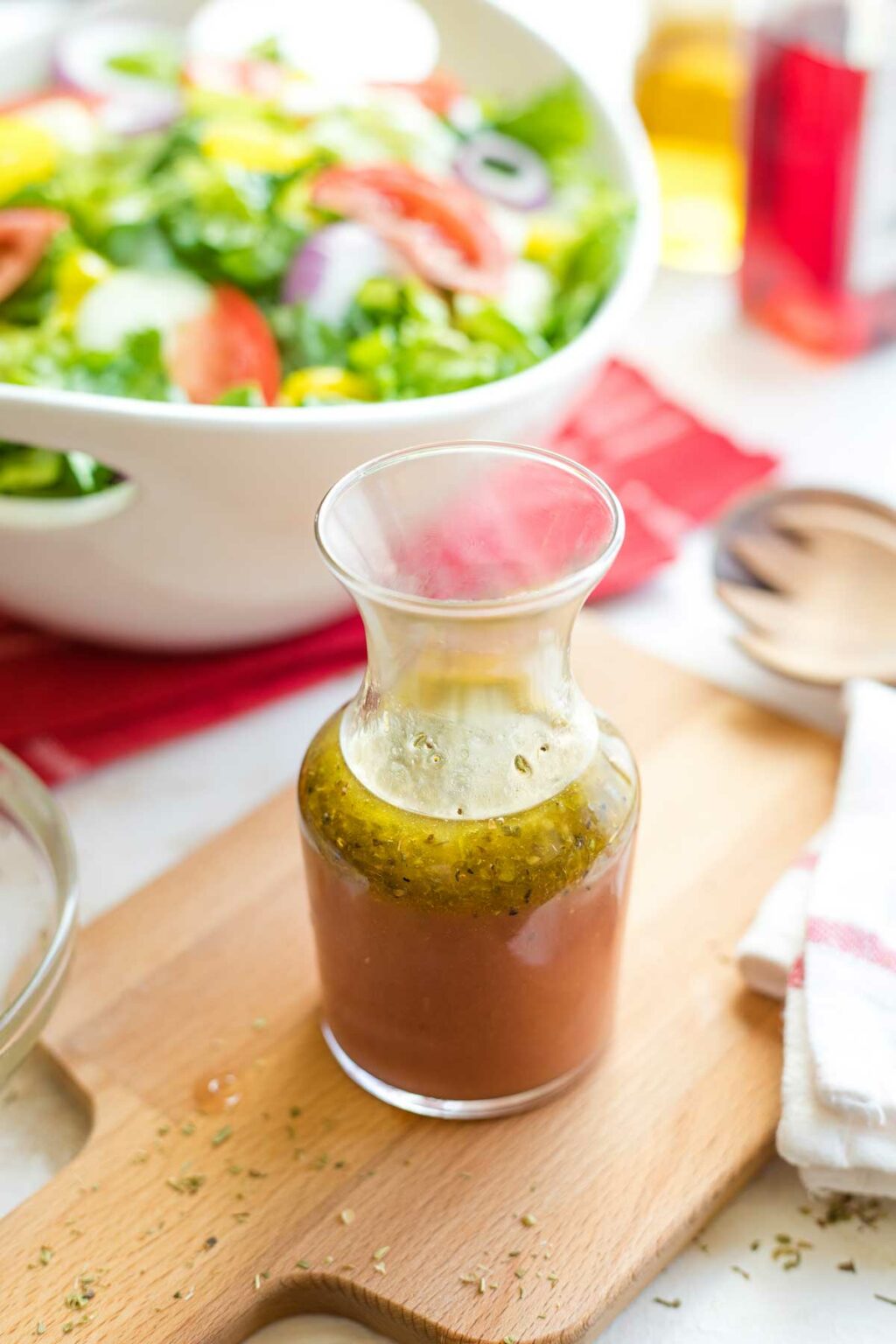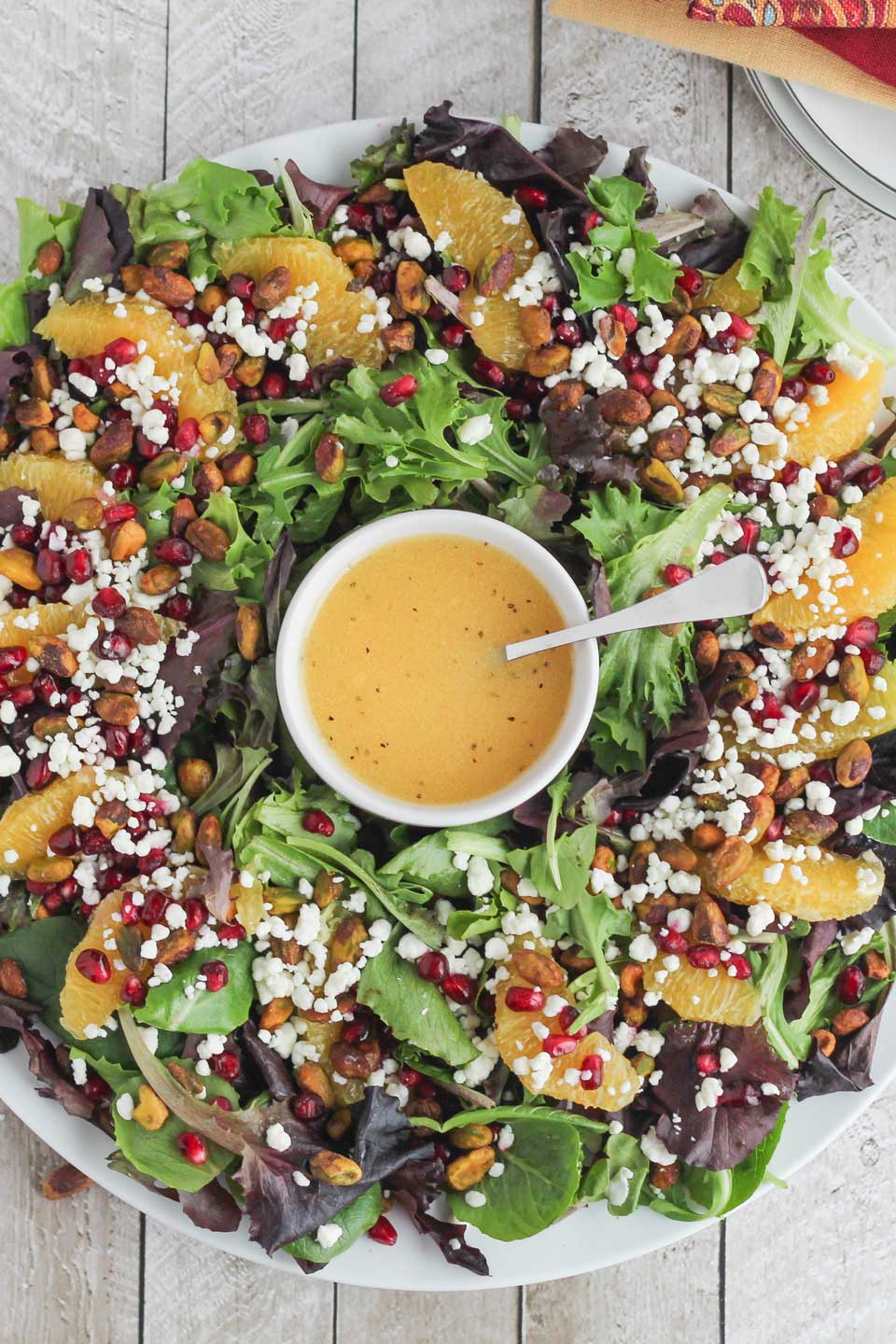White Balsamic Vinaigrette
~ This White Balsamic Vinaigrette is the perfect salad dressing for when you don’t want a “regular” brown balsamic to muddy the pretty colors of your salad. Lightly tangy-sweet and ready in just 3 minutes, this vinaigrette recipe is super easy and so delicious! (With a fantastic, sneaky bonus, too!) ~
This Recipe Is: • Ready in 30 Minutes or Less • Make Ahead • Vegetarian • Gluten Free •
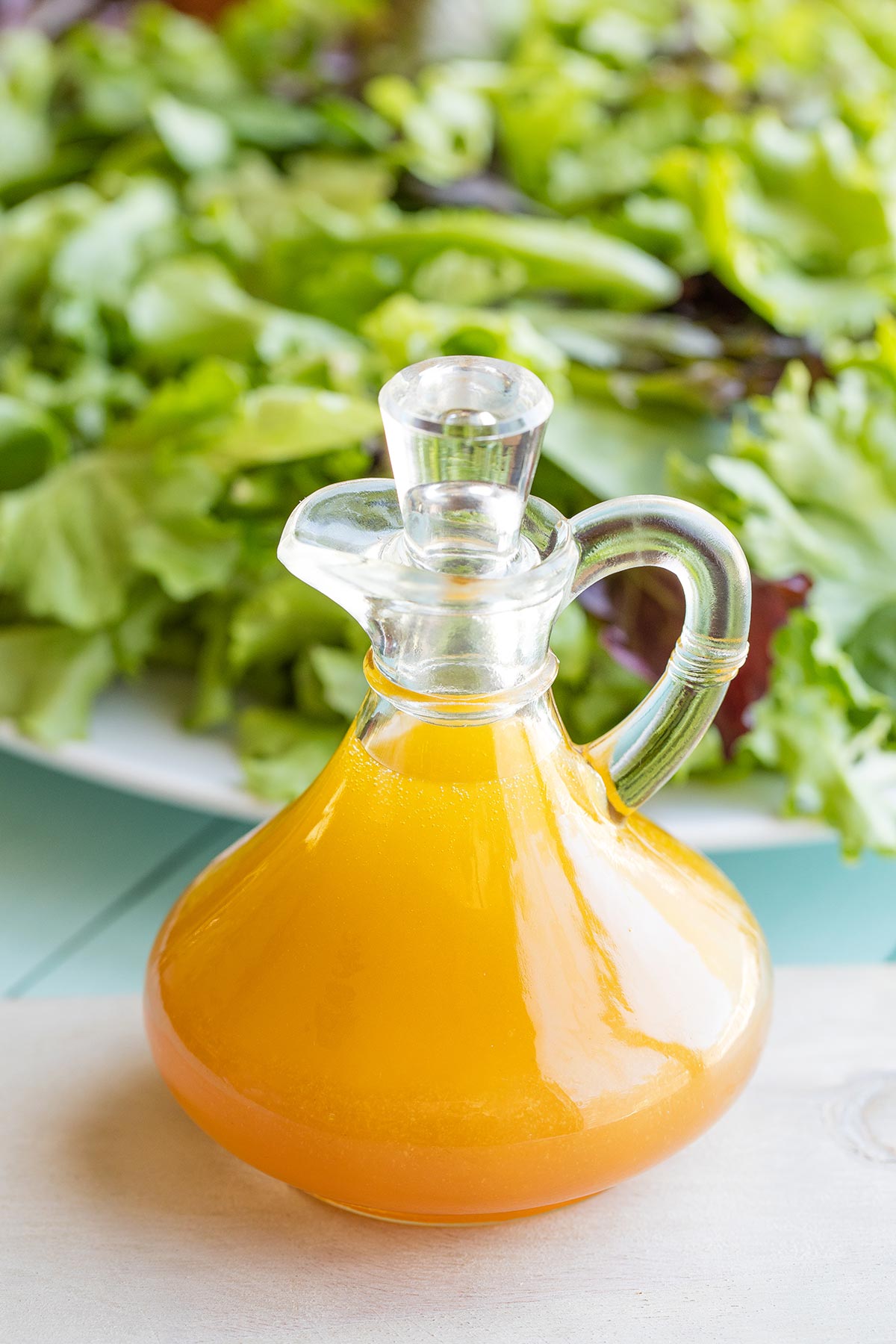
It’s definitely no secret around here that I (hands-down, no-contest, it’s-not-even-close) prefer homemade salad dressing over anything you can find on a store shelf.
Once you have that life-changing moment – when homemade dressing takes you by the hand and leads you to salad nirvana – it’s hard to settle for bottled dressing ever again. (My moment involved our Salad with Goat Cheese and Maple-Balsamic Dressing. Yeah … that was life-changing.)
Without question, homemade dressing wins every.single.time.
I mean, in practically an instant, you can whisk together something that actually makes salad seem SPECIAL. That makes even simple greens taste addictively delicious.
Suddenly, salad isn’t an afterthought … it’s the best part of the meal.
Plus, you know exactly what’s in it. Take this recipe, for instance. It’s so delicious with just a few, very simple ingredients:
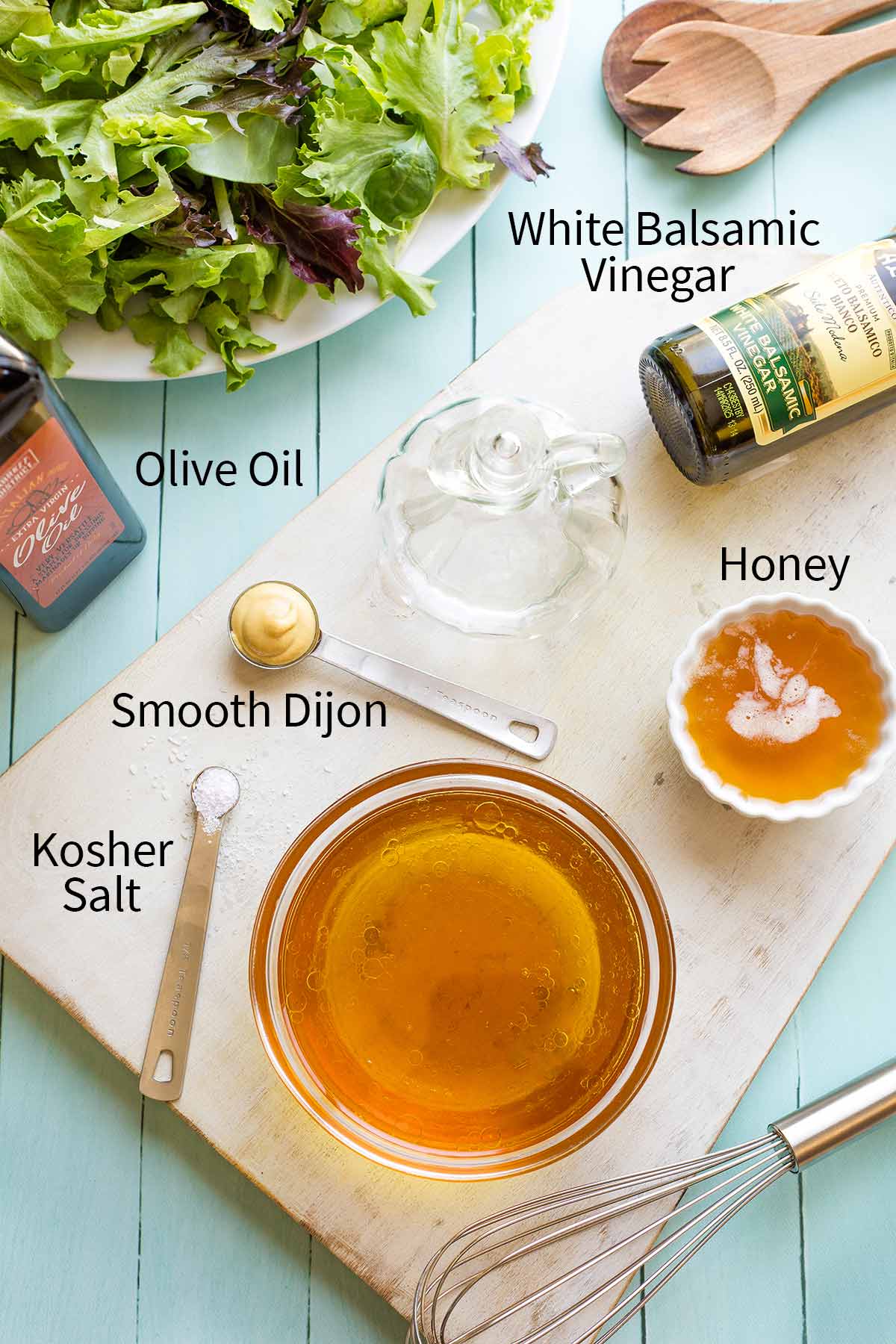
And when you make your own, it’s a snap to taste and tweak and adjust, if maybe you want your dressing a little tangier or sweeter or umami-er (or whatever) to match the salad you’re making. You’re in total control.
But even having said all that, you might be wondering why you need this specific White Balsamic Dressing in your life? I’m glad you asked!
Why You NEED This White Balsamic Vinaigrette
Reason #1: It’s deliciously lighter tasting.
Ok, obviously it’s delicious, right? I wouldn’t share this recipe if I didn’t love it!
But using white balsamic and honey creates a delightfully lighter, brighter flavor profile (as compared to, say, the “brown” balsamic and maple syrup I use in my popular Easy Maple-Balsamic Vinaigrette).
Subtle differences.
But those differences make this dressing ideal for times when you still want a balsamic vibe, but you don’t want to overwhelm more delicately flavored salad ingredients.
It’s tangy but sweet, bold but not overpowering. A “goldilocks,” just-right kind of salad dressing!
Reason #2: Some salads need a light-colored dressing.
Dark-colored dressings, like those made with regular (brown) balsamic, don’t always look very nice on salads.
Think of salads with colorful, pretty summer fruits, like berries or peaches or melon. Or even salads with slices of winter citrus.
Sometimes you don’t want to muddy the vibrant colors of your salad by drizzling it with a dark-brown dressing.
The solution is using white balsamic vinegar (sometimes called golden balsamic).
I actually first created this dressing specifically to grace my beloved Peach Salad with Cherries and Goat Cheese.
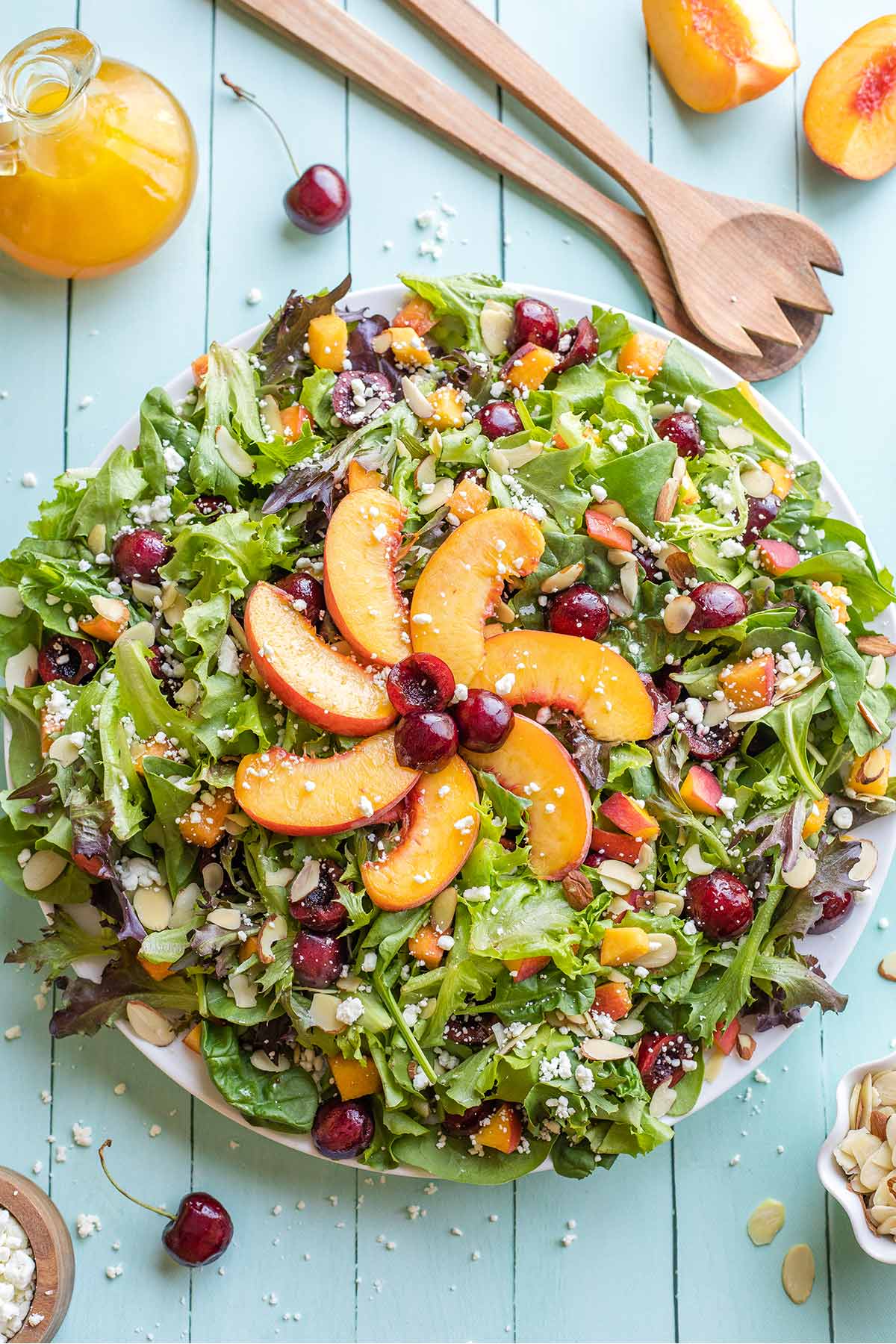
I didn’t want the vibrant, sunshine-y gold of the peaches or the bright white of the goat cheese to be marred by dribbles of brown vinaigrette.
This White Balsamic Vinaigrette kept my salad looking beautiful, and was the ideal, light-yet-tangy flavor companion, too!
Does White Balsamic Vinegar Taste Different Than “Regular” Balsamic”?
They actually do taste a little different, especially if you’re tasting them straight out of the bottle (but who really does that??).
Through my taste tests and recipe trials, I’d describe white balsamic as leaning toward a brighter, clearer finish (great for salads featuring lots of delicate fruits), while regular balsamic can be a bit heavier and more robust. Depending on how long it’s aged, regular balsamic may also have a deeper sweetness.
So, Can I Substitute “Regular” Balsamic for White Balsamic in This Dressing?
You can. And it will still be delicious.
Yes, the flavor will be slightly different. And, depending on how aged and sweet your “regular” balsamic is, you may want to decrease the honey (by maybe a teaspoon or two), to keep the dressing balanced. But overall, it’s still going to taste great if you don’t have white balsamic on hand and need to sub brown balsamic in a pinch.
Of course, though, it’ll be … you know … more brown.
Which is totally not a problem when you’re hurrying to get dinner on the table for a speedy, weeknight family meal.
But when you’re creating a masterpiece salad for a special potluck or party, and color actually does matter in the overall presentation … well then, white balsamic can be the absolute perfect choice.
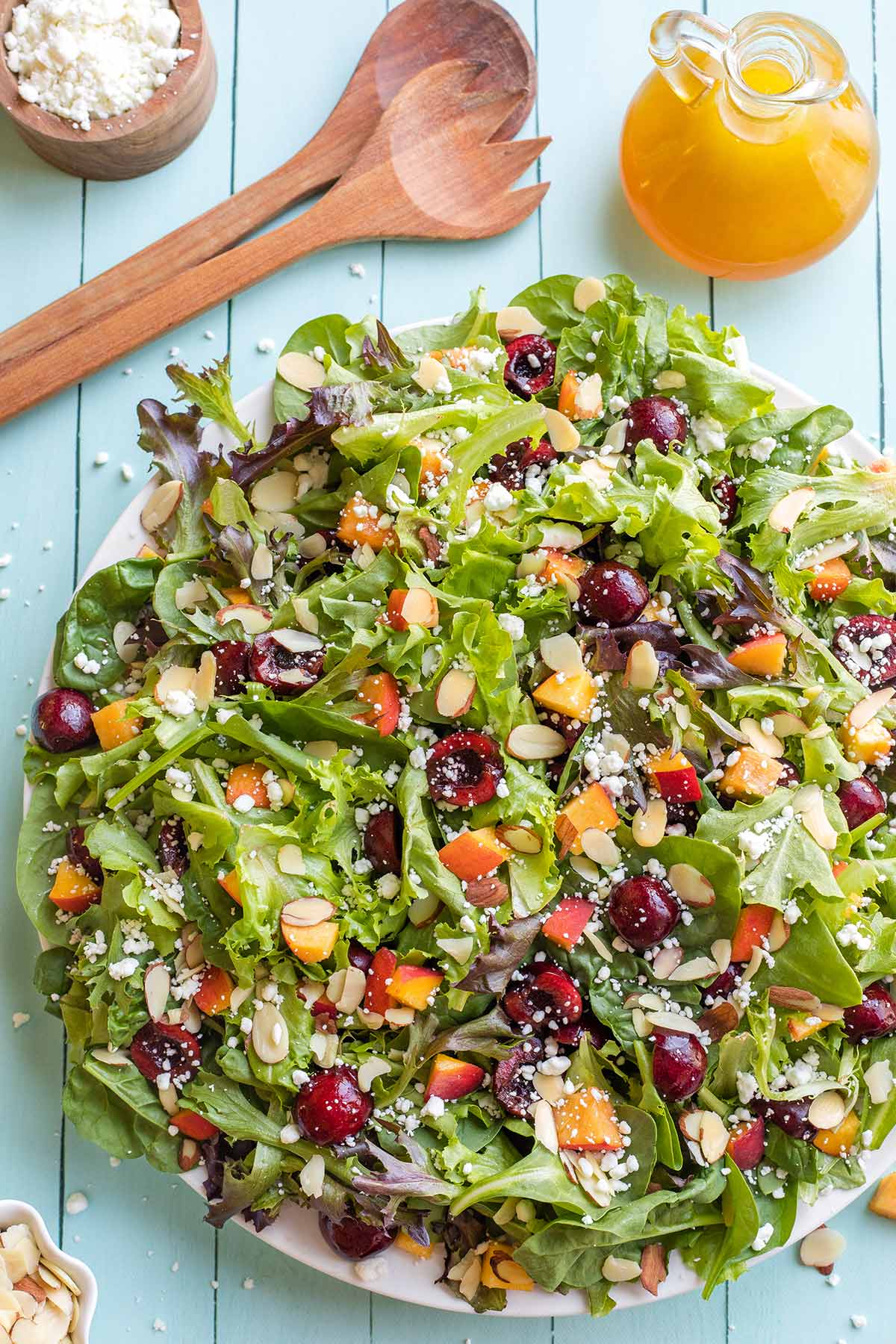
Oh – and remember how I mentioned that this vinaigrette recipe takes mere moments to make? I absolutely wasn’t kidding! Seriously … it’s THIS easy …
How to Make Your White Balsamic Dressing
Step #1 (the ONLY Step!)
Ready for this? Blink and you’ll miss it …
Whisk everything together in a bowl.
DONE!
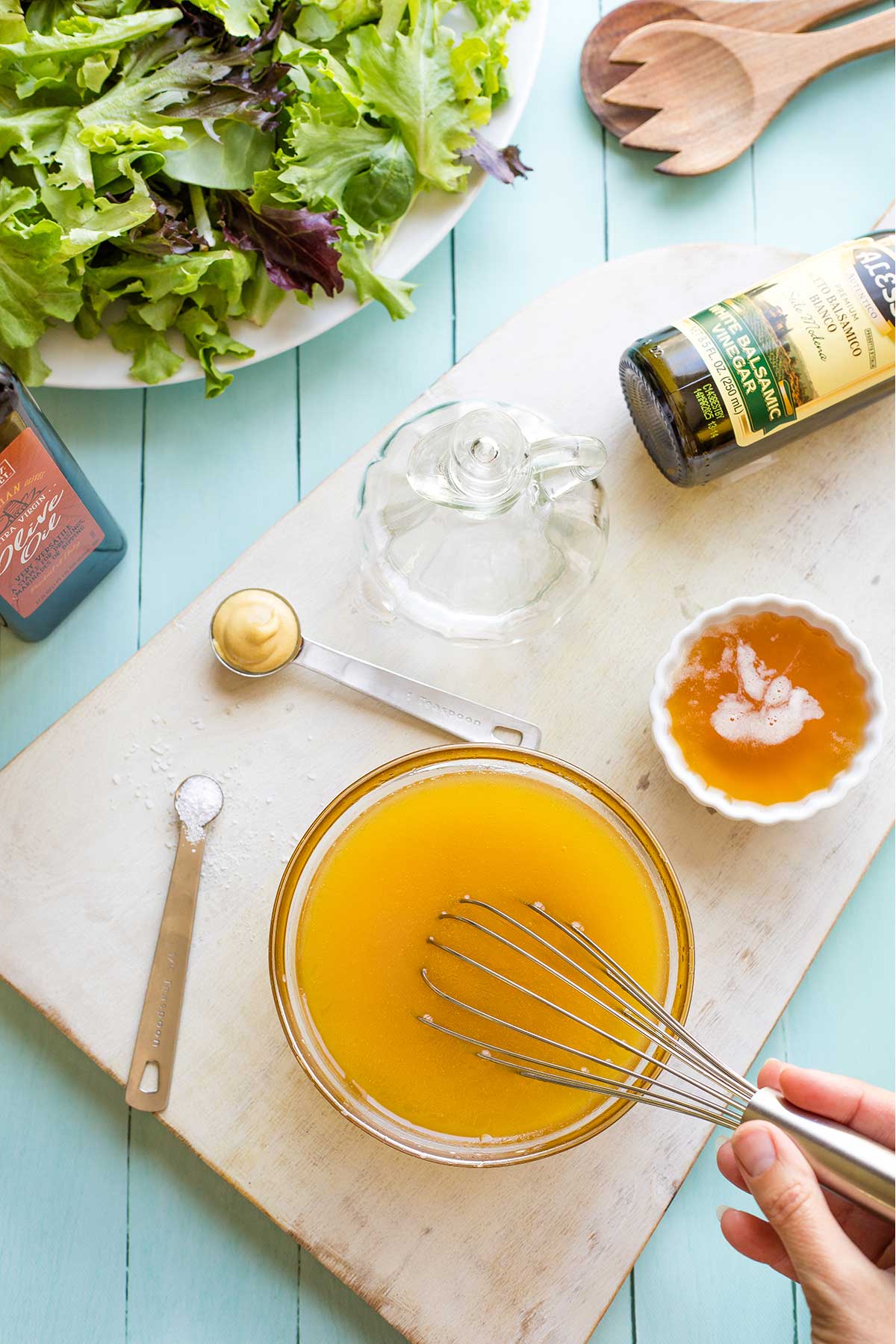
It’s truly that simple!
Pro Tip: Whisk Thoroughly
The only tip I have for you with such a very quick, easy recipe is to make sure you whisk thoroughly enough that the salt is completely dissolved.
And, if you’ve made your dressing ahead of time (since it keeps well for several days in the fridge), you may need to re-whisk it quickly before serving.
The {Surprising} Big Bonus
Wanna know a little secret?
This so-yummy-you’ll-be-licking-the-plate salad dressing is sneakily LIGHTER, too! (But don’t worry – nobody will notice, I 100% pinky promise.)
I personally don’t like overly oily salad dressings, to begin with. And I’ve found that simply tinkering with the standard proportions for a vinaigrette allows me to reduce the amount of oil I’m using. That lets the dressing’s flavors shine through, without being drowned in unnecessary oil.
And it lightens up your salad dressing. By A LOT!
The “typical” proportion for a vinaigrette recipe is 3 parts oil to 1 part vinegar (3 to 1). So, to make about 1 cup of salad dressing, you’d use 3/4 cup of oil to 1/4 cup of vinegar. (Yes, yes … I know one batch of this particular White Balsamic Dressing recipe actually yields 2/3 cup, not 1 cup. But I’m keeping the math simple here.)
Do you wanna guess how much fat and calories are in that 3/4 cup of oil? (Make sure you’re sitting down for this.)
Olive oil – like I’m using in this White Balsamic Dressing recipe – has about 1,400 calories and 168 grams of fat in 3/4 cup.
WOW.
Of course, you’re not gonna swig an entire cup of salad dressing. But I think you get the point. Even a couple little tablespoons would have nearly 200 calories and more than 20 grams of fat.
And yes … olive oil is now considered to be a relatively healthy fat in moderation. And seriously … how’s that salad (with all those extra calories) fitting in with your “I’m just having a salad and eating light today” plan?!?
Not so much. 🙁
The Solution
To solve this (and to keep my dressings from tasting like mostly just a lot of oil), I developed my own proportions for making vinaigrette recipes – proportions that use a fraction of the usual oil.
This technique maximizes the flavorful ingredients (like the vinegar and honey) while majorly reducing fat and calories.
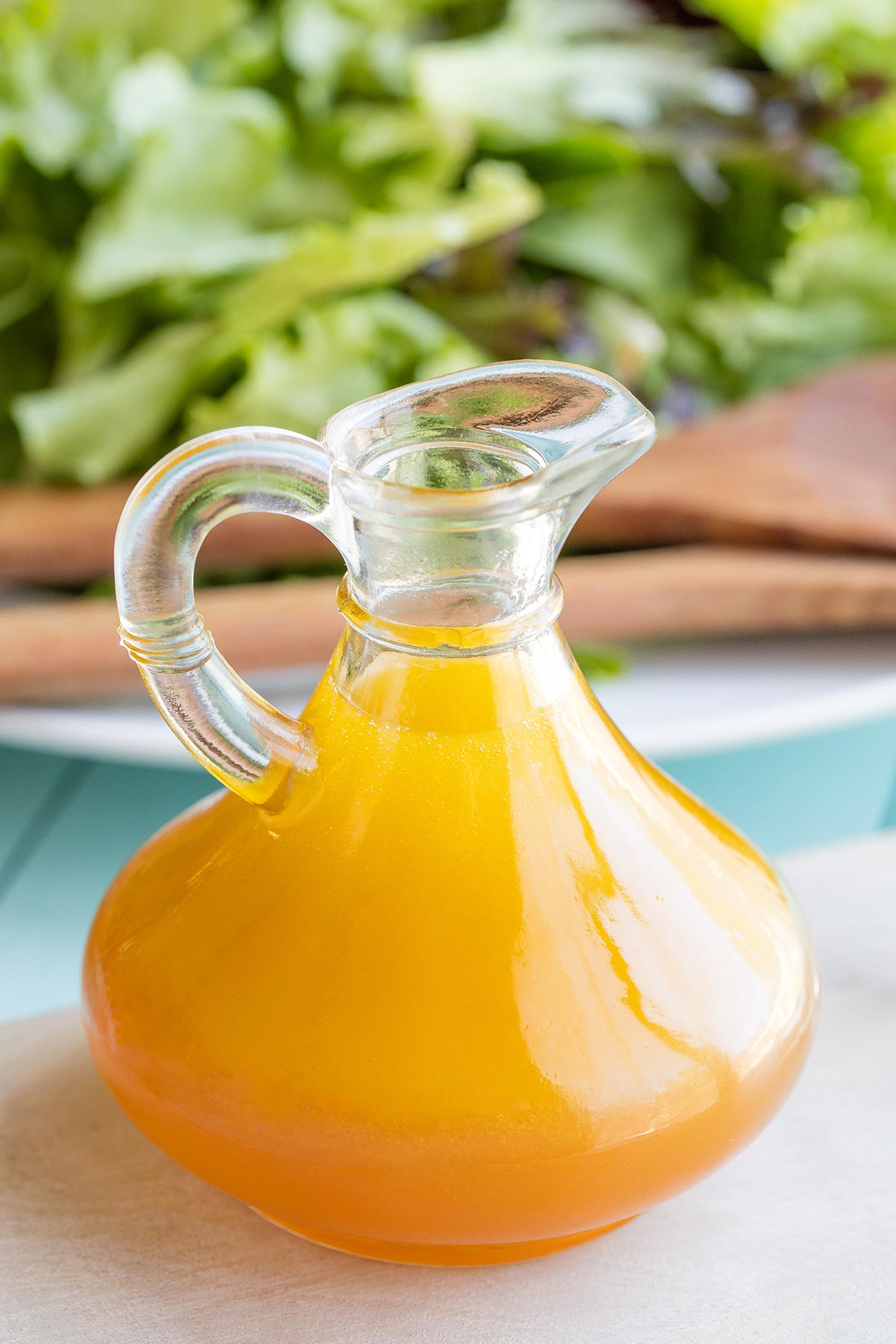
It’s the exact same strategy I use in my Red Wine Vinaigrette recipe and my Maple-Balsamic Dressing recipe.
An absolute win, all around!
Specifically, in this particular White Balsamic Dressing recipe, instead of the usual 3:1 ratio (again, that’s 3 parts oil to 1 part vinegar), I’m using a very different 1:2 ratio of only 1 part oil to 2 parts vinegar.
But again, nobody’s gonna be thinking, “Hey … is this dressing HEALTHY?!?” Nope. They’re never gonna think twice about it (although they’ll definitely think about digging in to fill their salad plate twice!)
Substitution FAQs
We’ve already discussed subbing “regular” brown balsamic in place of white balsamic vinegar. Here are a few more quick notes for the ingredients you might happen to have in your pantry.
I like the pairing of honey with many summer fruits, like melons, berries and peaches. But you can try maple syrup instead, in a pinch. It’d be especially nice with autumn salad ingredients like apples and roasted butternut squash.
Honestly, I’d stick with using smooth Dijon here. It has a richer, more complex flavor than plain yellow mustard, for example. And, you want to avoid the “grainy” version of Dijon, so your mustard incorporates smoothly and completely into the dressing.
And skipping it? I definitely wouldn’t recommend that. For one thing, it does add key flavor complexity. Plus, mustard also acts as an emulsifier in vinaigrette recipes like this one, helping to keep your dressing smoothly incorporated for longer.
I like olive oil in this vinaigrette for its nutrition profile and neutral flavor. If you don’t happen to have any on hand, though, you could try subbing another, neutral-flavored oil. An obvious option is extra virgin olive oil (instead of the “regular” / “plain” olive oil I recommend), but be aware that some extra virgin olive oils are notably more flavorful and aren’t as neutral. For this particular dressing, I didn’t want the flavor of the oil to be too prominent, which is why I suggest choosing plain olive oil if you have it.
The next time you’ve created a gorgeous salad full of pretty produce and bright white cheeses … and you can’t bear to ruin it by dousing it in brown dressing … hey hey! … now you’ve got the perfect solution!
Bonus that it just happens to be healthier for you, too.
Maybe even best of all, though??
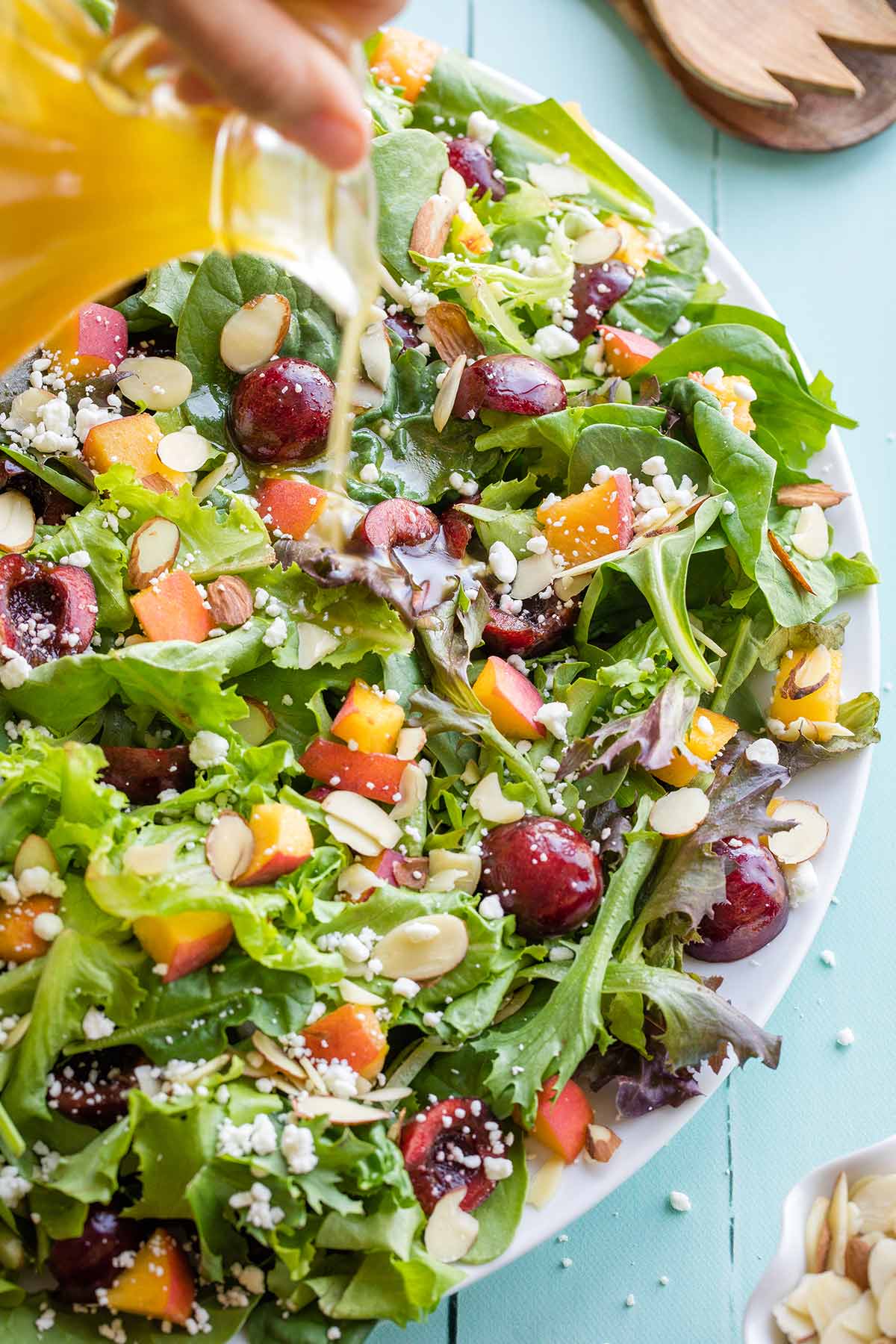
Since it’s so ridiculously quick and easy to make, you’ll never again have to compromise a fabulous salad by finishing it with a ho-hum, store-bought dressing!

~ by Shelley
Love the Recipe? • Were My Tips Helpful?
__________
Please leave a 5-star rating by clicking on the stars in the recipe card below. I truly appreciate all your wonderful feedback!
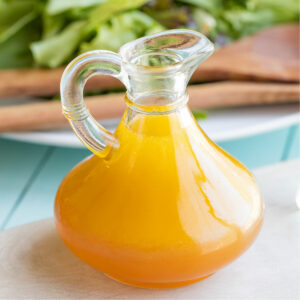
White Balsamic Vinaigrette
Ingredients
- ¼ cup white (or golden) balsamic vinegar
- 3 tablespoons honey
- 2 tablespoons olive oil
- 1 teaspoon smooth Dijon mustard (see gluten free note if needed)
- ⅛ teaspoon kosher salt
Instructions
- In a medium bowl, whisk together all ingredients until salt is dissolved and dressing is emulsified.
Notes
Nutrition
* Nutrition information should be considered an estimate only, and may vary depending on your choice of ingredients or preparation. No guarantees are made regarding allergies or dietary needs. Always consult a physician or dietician for specific advice and questions.

